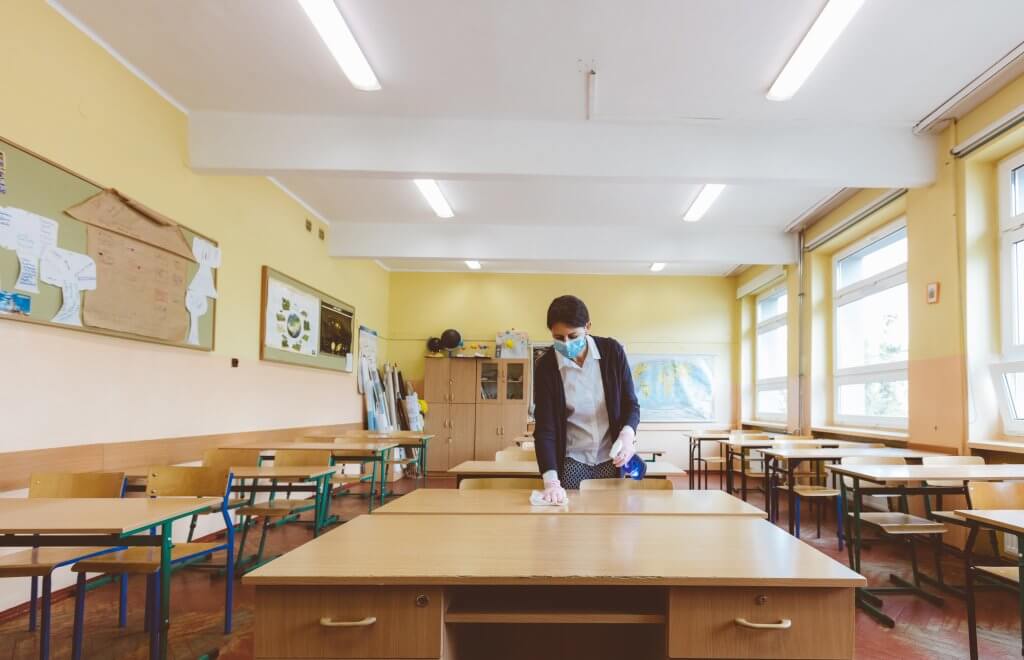After Budget Amendment, Some State Essential Workers Still Excluded From Hazard Pay

Earlier this month, Gov. Lawrence J. Hogan Jr. (R) reinstated hazard pay for essential state workers, but scores of them say that they continue to be left out.
In his supplemental budget released on April 2 and approved by the General Assembly, Hogan included a $1,000 bonus for all state employees, as well as $100 million to continue hazard pay for some essential state employees through the end of the year.
The $100 million will also be used to reimburse workers who stopped receiving coronavirus response pay in September, which is “when many other employers were discontinuing similar reporting incentives,” Nick Pepersack, spokesperson of Maryland Department Budget and Management (DBM), said in an email.
Although coronavirus response pay resumed on April 7, the Department of Budget and Management is still calculating the retroactive portion of the pay, Pepersack said.
However, the funding in Hogan’s supplemental budget applies to state workers who are currently receiving or have previously received hazard pay from the state.
At issue is the thousands of essential state workers who have been excluded from hazard pay since the beginning of the state of emergency and continue to be excluded in Hogan’s supplemental budget.
According to the Maryland’s largest state worker union — American Federation of State, County and Municipal Employees Council 3 — 8,000 union members are eligible for hazard pay and over 12,000 are left out. In state higher education institutions, all 6,000 workers are excluded from receiving hazard pay.
“I’m disappointed to learn that apparently there are thousands of state employees … that should have received the hazard pay rates — they weren’t restored,” Comptroller Peter V.R. Franchot (D) said during a Board of Public Works meeting last week.
“If we acknowledge their work is both essential and hazardous, I suggest that we should not exclude them from the hazard pay rates provided to their co-workers. Restoring hazard pay rates for those workers is the right thing to do,” he continued.
Hogan’s budget secretary, David R. Brinkley, said that the goal of the response pay was to ensure that the state had adequate staffing at critical places like correctional facilities and hospitals. He reminded the Board of the fiscal challenges as the state was facing “the unknowns” last fall.
The Department of Budget and Management decided not to expand the pool of essential workers qualified for hazard pay, he continued.
But labor unions contend that the DBM process to choose which essential state workers get hazard pay is arbitrary.
“There’s no consistency,” said Patrick Moran, the president of AFSCME Council 3. “It’s ridiculous that nurses and direct care aids in state hospitals are covered but then maintenance workers in the same building are left out.”
“We’ve been raising this issue for almost a year now,” he continued.
The state Department of Budget and Management deems those who could not socially distance as eligible to receive hazard pay. This includes occupations such as police sergeants, nurses in state hospitals and casework specialists.
Who’s left out?
State building security guards, administration staff in state correctional facilities, University System of Maryland employees and others say that there have been instances in which they could not socially distance, yet they are not qualified for hazard pay. They also argue it is unfair to work in the same space as other state workers who are receiving response pay.
“They tell us that were essential and we’re mission critical, but that you’re not worth anything extra, like everybody else is,” said Rebecca Stafford, 53, who has been a secretary at the North Branch Correctional Institution in Allegany County for 13 years.
Stafford was told she could not work from home during the pandemic because she was deemed “mission critical” by the Department of Public Safety and Correctional Services.
“I’ve got 80-year old parents that are both in congestive heart failure, and if I were to catch COVID and take it to them, it could more than likely end their life,” she said. “It makes me feel like we’re taking a risk, but the risk that we take doesn’t matter. It makes you feel like what you do doesn’t matter, like we’re expendable.”
Stafford is one of eight secretaries — who are all female and among the lowest paid employees at North Branch Correctional Institute, she said — required to work in person since the start of the pandemic without hazard pay. Meanwhile, other correctional employees, such as case managers, have had the option to telework and receive hazard pay, she said.
Dawn Becker, 41, another secretary at the North Branch Correctional Institute, said their work spaces are located across the inmate visiting room and operation area, where many frequent. She says she interacts with around 40 people a day and shares the same risk of exposure as other correctional employees.
Becker wrote to Brinkley last April asking for emergency response pay, but got no response. “Our work load in some cases has tripled as we have picked up duties that others working from home are unable to complete,” she wrote to Brinkley.
In August, a group of administrative staff filed a grievance with the Department of Public Safety and Correctional Services, but were told that they do not need hazard pay because they can socially distance.
“We travel in same main hallway, use the same restroom, kitchen area and go through the same security,” Becker said. She said her desk is five steps away from the offices of case management supervisors, the assistant warden, and lieutenants, all of whom receive hazard pay.
“If we have an opportunity to social distance, then so do all of those workers — we’re all right next to each other,” Becker said.
AFSCME Council 3 is currently in the middle of a larger grievance over hazard pay involving more than 5,000 state employees, possibly making it the largest grievance filed in the state history, according to Katie Mostris, communications director of AFSCME Council 3.
A victory would include full emergency compensation and acknowledgement of the sacrifices that all essential workers made, Mostris said.
“It’s very disheartening that it’s been a year and we’ve been told that people are fighting for us, and they’re not,” Becker said. “We’re not being given the same opportunities as other employees.”
Similarly, Janice Drivers-Waters, who has worked as a security guard with the Department of General Services for eight years, has not received hazard pay, and has been working alongside Maryland Capitol Police, who do.
Drivers-Waters is stationed at a loading dock in the back of the Department of Health building in Baltimore, screening various delivery people, warehouse workers and other employees every day.
“We all face the same unknown danger of being exposed to this virus,” she said. “What qualifies [police officers] to receive pay when we are all required to come to work?”
Higher ed workers excluded
AFSCME Council 3 is also concerned that state higher education essential employees have been entirely excluded from hazard pay, even though some were working in buildings used for quarantining students. Decisions about hazard pay for state college employees are made by the University System of Maryland, not the Department of Budget and Management, Pepersack said.
But the University System of Maryland claimed it has provided additional pay to its employees throughout the pandemic.
“University System of Maryland institutions did indeed provide additional pay or administrative leave to many of those employees,” Mike Lurie, spokesperson of USM said in an email. “At some USM institutions independently, there has been agreement with union representation on the issue of hazard pay.”
Celina Sargusingh is a health center clinic coordinator at the University of Maryland, College Park and has been doing a mix of in-person work and telework since last March. Alongside other university employees, she says she has not received hazard pay even though social distancing is not possible all the time.
“There is no social distancing when you are taking patient’s blood pressure or their temperature, there’s no social distancing when I’m swabbing thousands of patients for the COVID testing … there is absolutely no social distancing for frontline workers — that’s why we’re called frontline workers,” Sargusingh said.
Whether or not a nurse is working at a state hospital or at a state university, “a nurse is a nurse,” Sargusingh said, and if one is receiving hazard pay, the other should too.
This year, the Maryland General Assembly passed a bill that would require the chancellor of the University System of Maryland to act on behalf of all the system’s institutions during collective bargaining, aiming to consolidate the bargaining process. This would make asking for hazard pay, among other demands, a little bit easier, Sargusingh said.
“It’s like a double standard — they want to call us heroes but where’s the compensation for that? It’s selective,” she continued. “There is enough funding to make [hazard pay for all essential state employees] happen, but there just isn’t enough compassion to make that happen.”




 Creative Commons Attribution
Creative Commons Attribution